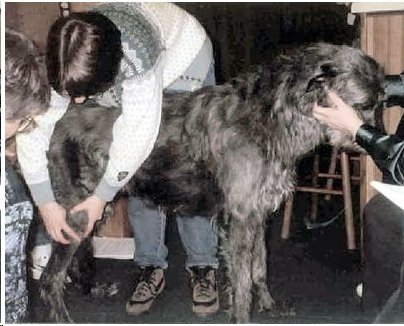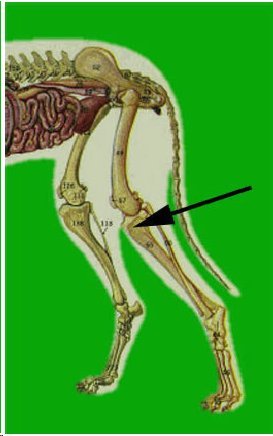Introduction:
Many pet owners write and ask my opinion on Gastropexy surgery for
bloat prevention. As breeders, most of us do not do the surgery, because
we have come to the conclusion that although we do not know the true
cause of Bloat, it is best not to tamper with breeding stock, just
in case this has a genetic predisposition.
I for one do not believe it is genetic, but a "systemic"
problem caused by a breakdown in the pH of the gut, due to multifactors,
and stress is the trigger. For more detailed information here is my
article on the issue of Bloat/Gastric
Torsion.
I also feel you need to know about the yeast/fungus
connection to bloat and how to help prevent this condition with a
comprehensive feed program.
For pet owners, below is information you should print out and share
with your vet. There is a new technique called Laparoscopic gastropexy
that is by far less invasive then the traditional belt-loop gastropexy
and this is the techinique you might want to consider.
Information courtesy from the www.pubmed.gov
website - to help you and your vet make a decision on doing gastropexy
surgery.
Vet Surg. 1996 May-Jun;25(3):221-7. Related Articles, Links
A Comparison of Laparoscopic and Belt-loop Gastropexy in Dogs.
Wilson ER, Henderson RA, Montgomery RD, Kincaid SA, Wright JC, Hanson
RR.
Department of Small Animal Surgery and Medicine, College of Veterinary
Medicine, Auburn University, AL, USA.
A simplified technique for laparoscopic gastropexy (group 1) was compared
to belt-loop gastropexy (group 2) in eight adult male dogs randomly
divided into two groups of four dogs each. Our hypothesis was that
a satisfactory laparoscopic gastropexy would approximate the strength
and operative time required for belt-loop gastropexy. Operative time,
surgical complications, postoperative morbidity, gross and histological
appearance, radiographic microvascularization, and maximal tensile
strength were measured and compared between the two groups. All dogs
recovered from surgery. No morbidity was associated with either procedure.
The mean (+/- SD) duration of surgery was 69.75 +/- 7.23 minutes for
group 1 and 58.75 +/- 7.63 minutes for group 2. Fifty days after surgery,
the microvascular appearance of the gastropexy site was similar for
both groups. Blood vessels were observed within each seromuscular
flap but vascular ingrowth to the abdominal musculature was observed
in only two dogs, one from each group. The maximum tensile strength
at 50 days was 76.55 +/- 22.78 for group 1 and 109.21 +/- 22.29 N
for group 2. Differences between surgical duration and maximum tensile
strength were not statistically significant (P > .05). Histologically,
all gastropexies consisted of an adhesion composed of dense fibrous
connective tissue. The results of this study indicate that laparoscopic
gastropexy provides a minimally invasive alternative to open abdominal
prophylactic gastropexy in dogs.
PMID: 9012107 [PubMed - indexed for MEDLINE]
_____________________________________________________________________
This article is courtesy of Vet Surgery Central, please print
out and take to your vet if you are considering gastropexy surgery
on your Great Dane
http://www.vetsurgerycentral.com/proph_gastropexy.htm
Minimally Invasive Gastropexy - a Preventative Procedure
Article Written by Dr. Daniel A. Degner, Board-certified
Veterinary Surgeon (DACVS)
Key Points:
A procedure called a gastropexy can be done to tack the right side
of the stomach to the right side of the body wall using minimally
invasive surgery.
Benefits of the laparoscopic surgery:
Shorter surgery and anesthesia time
Less pain
Quicker recovery
Prevents life-threatening twist of stomach
Less expensive than treating life-threatening GDV
Patient can go home on the day of the procedure
Indications:
Gastric volvulus and dilation (GDV) or bloat is a common life-threatening
condition that affects many large breeds of dogs; for information
on GDV look at GDV web page. This condition involves distention of
the stomach usually with gas and twisting of the stomach. Why wait
until the life-threatening condition has occurred? A preventative
minimally invasive procedure is now available for your pet. Breeds
that are susceptible to GDV and should be considered for the preventative
procedure
Great Danes
Irish Wolf Hounds
German Shepherds
Standard Poodles
Blood Hounds
Laparoscopic surgery
A procedure called a gastropexy can be done to tack the right side
of the stomach to the right side of the body wall using minimally
invasive surgery
A scope is inserted into the belly cavity
An instrument port is made on the front right side of the abdomen
and the right side of the stomach is picked up with a laparoscopic
instrument
The instrument port incision is enlarged to 1 1/2 inches and the stomach
is sutured to the right body wall
Benefits of the laparoscopic surgery over open surgery
Shorter surgery and anesthesia time
Minimally invasive
Two small incisions therefore less scaring
Less pain
Quicker recovery
Prevents life-threatening twist of stomach
Less expensive than treating life-threatening GDV
Patient can go home on the day of the procedure
Where to Purchase A Bloat Kit
Editorial Comments:
Here is the recommended surgery
guidelines for Great Danes, from the Great Dane Club of America
Health and Welfare Committee. Print out for your vet.
It is best to have your dog in top condition before going into any
elective surgery, and a comprehensive
feed program and the use of Nzymes
for detoxification and fast healing is very important.
I would like to include this information as well.
Accpuncture and Bloat
- By C.A. Krowzack, DVM
This article is reprinted here with the
kind permission of theGreat Lakes Irish Wolfhound Association and
Dr. Chris Krowzack.
In February of 1998, the Great Lakes Irish Wolfhound
Association (GLIWA) held their annual meeting. The meeting is an occasion
for fellowship of the members; the club attends to business and also
hosts a speaker on a special topic. In the past it has been obedience,
therapy dog training, and this year the topic was acupuncture. Dr.
Debbie Mitchell gave an overview of what acupuncture is, its history
and its medical uses. Then, using a member's dog showed the participants
several acupuncture/acupressure points that they could utilize. One
point was to stimulate gastrointestinal motility to combat bloat.
This week at my clinic, a GLIWA member brought her wolfhound in for
an examination. During the night Quinn had begun experiencing discomfort.
He sleeps in the bedroom with his owners. The husband had worked a
long day and was asleep, but the wife was awakened by the restless
behavior of Quinn. When she petted him she found his abdomen severely
enlarged and hard to the touch. She knew it was bloat, but didn't
know what to do. She is a small woman, and Quinn a large dog. She
remembered the acupressure point Dr. Mitchell had shown and began
massaging it. Within a few minutes, Quinn began passing "a lot
of gas" and his abdomen became smaller and softer. The husband
and wife brought Quinn in the next morning to make sure he was all
right, and because he had diarrhea.
On examination, Quinn was completely normal. He was not experiencing
discomfort upon palpation, and no abnormalities beside the diarrhea
could be found. Because she remembered the acupressure point, the
wife had saved Quinn's life. The acupressure point is on the hind
leg. If you start at the hock, on the front of the leg (anterior)
you can feel the tibia. Move your hand up the leg along the tibia's
sharp crest; what in humans would be called the shin. As your hand
approaches the stifle, or the "knee" the crest becomes very
pronounced and then curls around to the outside (laterally). Just
inside this curve is a depression. The acupressure point is in this
depression. An acupuncturist might insert a needle into this spot,
or inject a liquid, but, as Quinn's owners will attest, massaging
also stimulates the point. The gastrointestinal tract starts to
contract and move (peristalsis) and expels the built up gas before
torsion can occur. If torsion has occurred, massaging the spot will
not help.I don't recommend this procedure instead of veterinary treatment,
but begun early, or on the way for veterinary treatment, can save
your hound's life!
A further note, Dr Krowzack has studied acupuncture at Colorado State
University Veterinary College this past year and is now a board certified
veterinary acupuncturist.


For more information on the various types of Gastroplexy surgeries
go to: http://www.gdca.org/health/GDVBloat.htm

